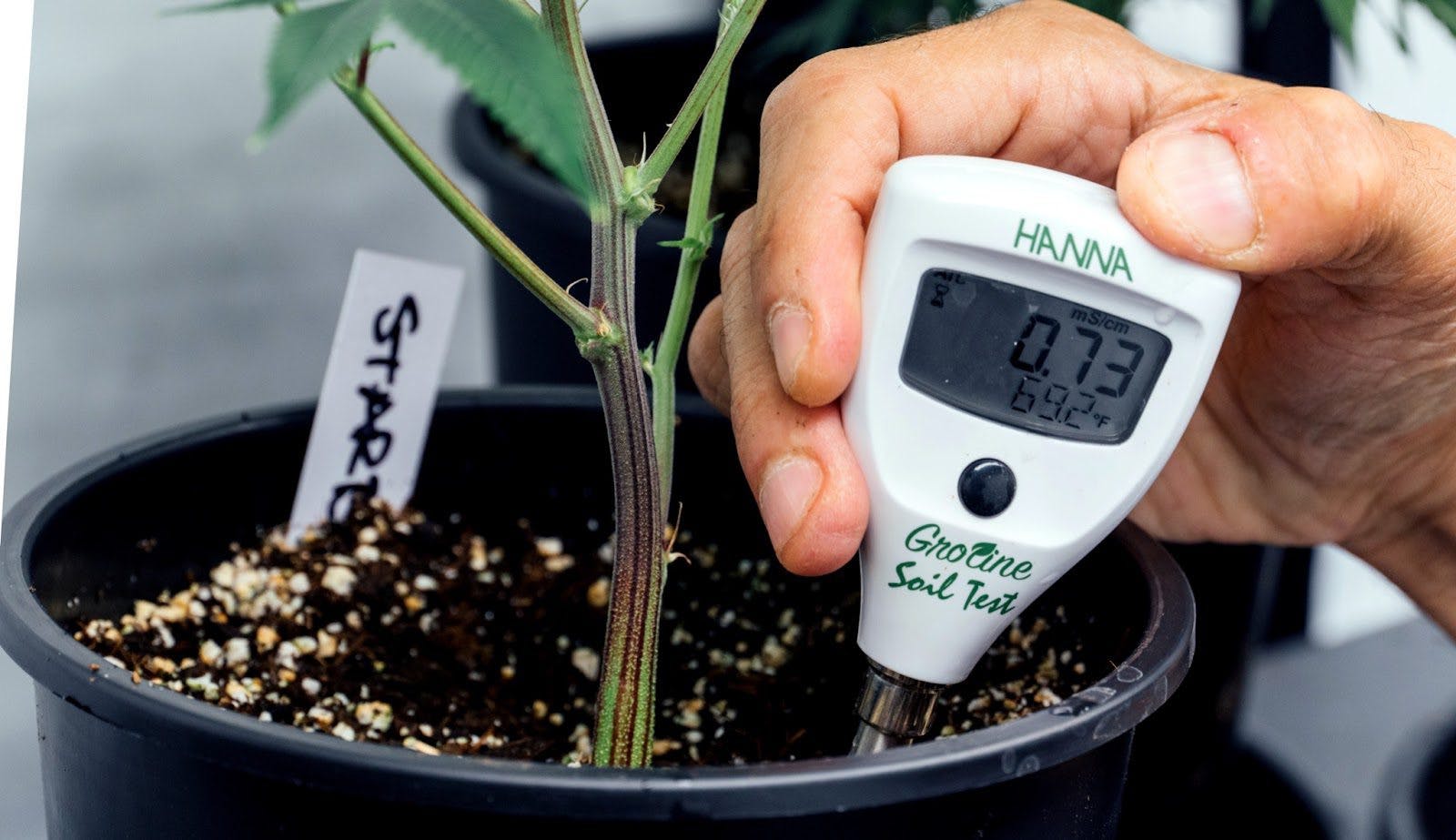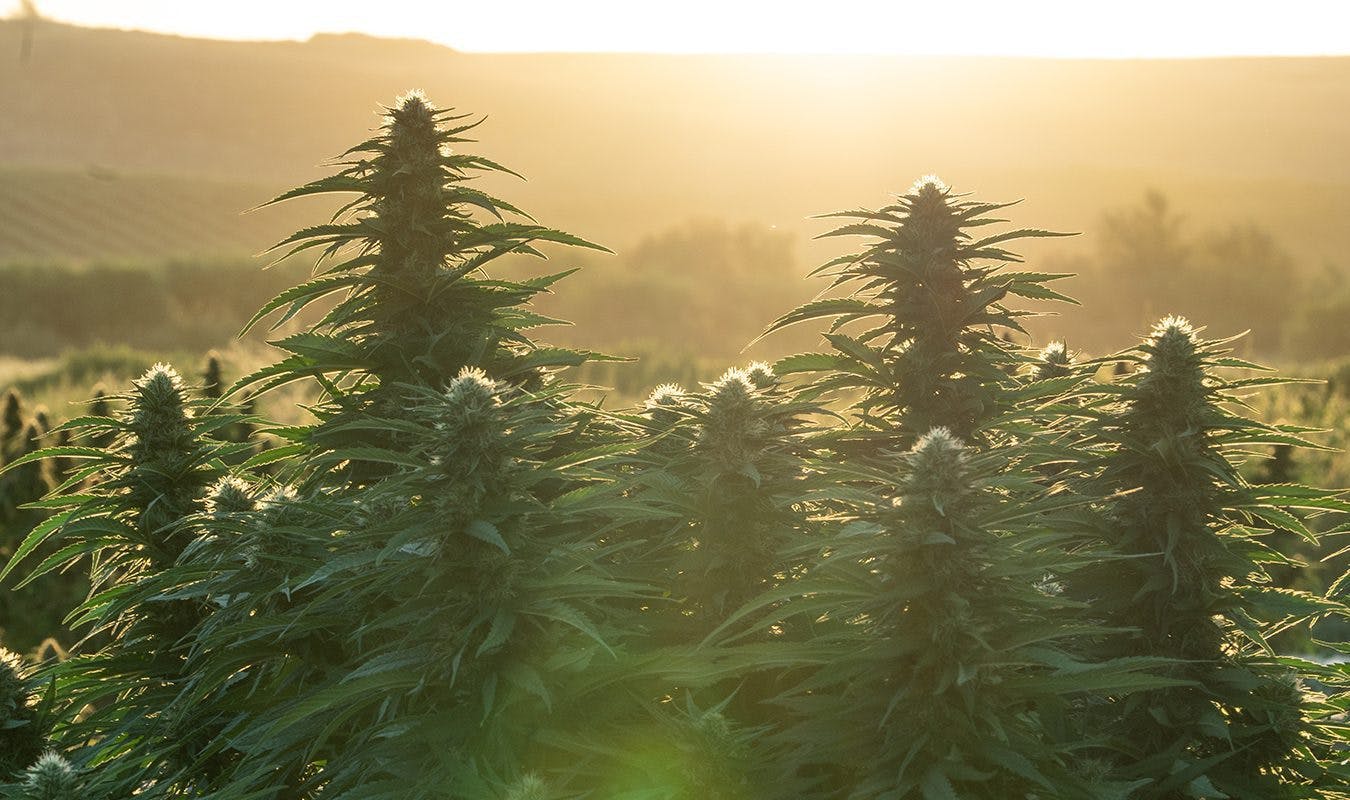What’s the Ideal Temperature for Growing Cannabis?

Article written by

Homegrown Cannabis Co.American Seed Bank and Cultivation Experts
Content reviewed by

Dr. Lewis JasseyMedical Director - Pediatric Medicine
The ideal temperature for growing weed is 77°F for seedlings and clones, 85°F for vegging, and 80°F for flowering. Variations are acceptable, but keeping the environment close to ideal ensures you get heaps of sticky buds.
Cannabis prefers balmy conditions and dries and dies when it’s too hot or cold. The life stage and land of origin affect a strain’s (cultivar’s) preferences, but they’re generally non-negotiable. As a result, knowing how to keep heat in check is one of the tenants of cultivation success.
Get your medical marijuana card
Connect with a licensed physician online in minutes.
Ideal Temperatures for Every Growth Stage
Temperature determines growth levels, overall health, and future harvest quantity and quality. Understanding this plant requirement is one of the cultivation essentials to master in any set-up.
As a rule, cannabis enjoys warm conditions during the daytime and slightly cooler temperatures at nighttime. Plants perform most of their life functions when the lights are on and use the cooler period of darkness to recover.
Here’s what figure to aim for in each stage of development.
Seedlings or Clones
Seedlings and clones are vulnerable and require moderate warmth to grow. They do best in 68-77°F and high humidity conditions. The dark period requires 59-68°F.
Overheated clones and seedlings wilt and lose their brilliant greenery. They stop developing if they get too chilly.
Expert tip: Maintain this precise range until your young plants have at least three nodes and three-inch-long roots. If growing in a harsh outdoor climate, keep them indoors to set them up for success.
Vegetative Stage
Cannabis plants in the vegetative stage enjoy hotter environments than seedlings. Most strains thrive under 70-85°F (65-75°F at nighttime) with moderate humidity. Lower lights-off temps tend to lead to more prolific growth during lights-on hours.
Heat stress in vegging manifests as dry foliage with curled edges and yellow or brown spots. You might also notice burn marks on leaf tips. Overly cold air halts development, damages the root system, and makes plants susceptible to mold and powdery mildew.
Flowering Stage
Flowering plants prefer slightly cooler areas than vegging ones: 70-80°F during the daytime and 65-75°F at night. They do best in low humidity.
Maintain the above ranges throughout flowering if you’re a beginner. Advanced cultivators can further reduce temperatures in the second half of this stage to promote bud growth and quality.
Aim for 65-75°F during the daytime to supercharge bud density, potency, smell, and trichome production. Strains with purple pigments exhibit gorgeous hues when the nighttime temps are around 55°F in the final two weeks of maturation.
Overly high temperatures in flowering can burn away the trichomes and leave you with dry, weak weed. If the humidity also rises, your plants are at risk of bud rot. Going under 55°F can stress them and reduce their harvest potential.
Monitoring Temperature
As we saw above, cannabis enjoys similar conditions to humans during most of its life cycle. Does that mean you can keep marijuana plants at room temperature?
You could, but the climate can be unpredictable. Plants suffer heat and cold stress if there’s a considerable spike or drop, so why put them at risk? You can avoid plenty of gardening trouble by purchasing and keeping an eye on a thermometer.
Cheap gadgets from local stores will do the trick, but they can be several degrees off. Consider purchasing multiple and placing one parallel to the plant base, one at canopy level, and one near the grow lights. Since hot air rises, it’s good to know if there’s a significant fluctuation in your space.

Get a device that connects to your smartphone if possible. That way, you can immediately respond to spikes and drops when they happen. High-budget cultivators may consider smart thermometers, while outdoor growers can rely on the weather forecast instead of devices.
Here’s what can mess with your readings:
- Grow light activity: HPS lamps run hot and can quickly warm the grow area. Either account for their heat emissions or stick to cool LEDs.
- Appliance activity: CO2 emitters, humidifiers, and exhaust fans can get warm when left active for too long.
- Poor insulation: If the weather outside gets too cold and your room isn’t well-insulated, the outdoor chill might enter it.
Don’t worry about temporary spikes and drops, but react if the space remains under or over the suitable range for several hours. Here’s how you can restore the optimal temperature.
How to Regulate Temperature
Maintaining the ideal temperature in your growing environment guarantees you’ll get healthy, high-yielding cannabis. Before discussing ways to correct excessive or inadequate heat, let’s see how precise you need to be.
Marijuana is sensitive when young and sturdier with age; its capability to withstand imbalances increases in vegging. You don’t need to stress about every slight temperature fluctuation, but react when it exits the optimal range.
Indoor weed gardens require more precision than those in the open air. Outdoor plants are resilient enough to withstand extreme conditions for several days. As long as you don’t see symptoms of ill health, don’t worry too much about the weather.
The strain origin also affects sensitivity. Sativa and indica cultivars originated from different climate conditions, so their preferences vary. Sativa plants can take extra heat, while indica fares better in slightly cooler weather.
Expert tip: Purchase resistant strains if it’s your first time growing cannabis. That way, you can master the basics of climate control without compromising harvest size and quality. Check out our partner Homegrown Cannabis Co. to buy high-quality seeds and get started.
What if the weather is too harsh for too long? Let’s see how to ensure the ideal temperature for growing weed in either setup.
Regulating Temperature Indoors
Heat and humidity are the two main components of growing healthy indoor plants. Cultivators use thermometers and hygrometers to ensure the conditions are conducive to ample harvests.
Here’s what you can do if the grow room gets too cold:
- Install a space heater with a thermostat. These devices blow warm air into the space and gently increase its temperature. Choose them instead of radiators to avoid burning the plants.
- Place a heating mat on the floor. These nifty items propagate seeds, but their utility doesn’t stop there: they can also shelter plant roots from cold damage.
- Scale up your lights. HPS lamps emit heat while active, and they could raise the temperature by several degrees.
If grow room temperatures get too high, here’s how you can drive them down:
- Install a space cooler or air conditioner. Pick a device that automatically shuts down once the space reaches a specific temperature. You can also implement a large-scale system that simultaneously regulates heat, humidity, and ventilation.
- Increase the airflow. Implement a bigger tube vent or operate your fan at a higher speed. You could also open opposing windows to let cold air enter and warm air exit.
- Regulate the lamp temperature. Consider getting a cool tube if your HPS light is heating the space. These glass devices suck out the warmth emitted by the lamp.
- Switch the days and nights. Since device activity increases heat, you might run the lights-on hours during the cooler nighttime.
Remember to keep your temperatures and relative humidity balanced. The availability of water vapor decreases as the air becomes scorching, and your marijuana suffers. Likewise, freezing conditions increase moisture and can cause plant disease.
Always measure and regulate these two aspects of your grow space together. Adjust the temperature first and then employ devices to fine-tune humidity accordingly.
Regulating Temperature Outdoors
Outdoor spaces leave some aspects of the growing process outside your control; temperature is one of them. You can’t affect cold or hot weather, but you can check local forecasts and prepare for whatever’s coming.

Is your region too cold for cannabis? Here’s how you can regulate it and keep plants cozy:
- Use compost as a heat source. Dig a trench around your weed garden and fill it with organic matter. It’ll warm up when exposed to sunlight and release warmth when it gets chilly at night.
- Place warm bottles around the plants. Fill dark barrels or bottles with water and leave them exposed to sunlight. They accumulate heat and protect your weed from the cold.
- Supply plants with warm water. This temporary heat source can keep the roots safe until the weather clears.
- Use frost cloth on the leaves. These materials keep dew from settling, freezing, and damaging the foliage.
You’re more likely to face excessive heat while growing weed outdoors. Here’s how you can reduce it:
- Provide shade to your garden. Direct sunlight exposure fattens buds but can harm plants if too intense. Move potted plants to a shaded area or erect bamboo branches and cover them with a light-colored cloth.
- Water plants in the early morning. When cannabis consumes moisture, it releases some of it through its foliage to cool itself. Early morning showers ensure transpiration happens during the hottest part of the day.
- Increase the ventilation. Move potted weed to a breezy spot, or place wireless fans around your garden. Stagnant air harms plant health and development, especially when it’s scorching.
If you’re concerned about heat stress, you can also use seaweed extract and silica supplements on plants. These increase their resistance to hot weather.
Note that relative humidity reduces when the air is too warm. To compensate, crops consume more moisture through their roots and may suffer nutrient burn. If dealing with a temperature spike, mist the foliage with water to prevent this issue.
Get Your Medical Card
Connect with a licensed physician online in minutes.
Frequently Asked Questions
What’s the best temperature for a grow room?
The best temperature for a grow room is 70-80°F. Readings under 60°F can stunt plant growth and eventually kill them. The buds don’t get as sticky, potent, and tasty if the space remains over 90°F for too long.
What is the right temperature and humidity for growing weed?
The optimal temperature and humidity for growing cannabis vary with the life stage. As a rule, the grow room should always stay at 65-85°F and 40-60% relative humidity. If growing indoors, you can specify these ranges for higher yields.
Seedlings enjoy warm spaces with higher moisture levels, and vegging plants like hot and relatively humid conditions. Flowering marijuana thrives in dry air and moderate heat.
What should the temperature and humidity be in a grow room?
The grow room should have temperatures in the 70-85°F range and 40-65% relative humidity while your plants are vegging. Begin at the high end of the humidity range and reduce it by 5% each week.
The flowering stage goes best when the space has 70-80°F and 35-55% relative humidity. It’s advisable to start high and gradually decrease both metrics.
